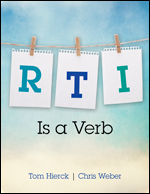Making RTI an Action Verb
RTI Is a Verb
By Tom Hierck and Chris Weber
(Corwin, 2014 – Learn more)

RTI…Few in the educational field have been able to avoid this term and the power it holds. When I was first introduced to the Response to Intervention model, I immediately latched on to the philosophy behind the approach, but in the back of my mind I wondered: how can I implement this effectively?
When I saw the title of the book, RTI Is a Verb, by Tom Hierck and Chris Weber, a silent cheer went out. RTI is an action and not a complacent activity that teachers hope will happen. Educators around the world end their days asking themselves “what could I have done differently to meet the needs of individual students?” They look for answers through data and homework assignments.
RTI Is a Verb breaks down the RTI process into concrete pieces that can be implemented in the classroom. The teacher is no longer left alone wondering where to begin.

- Introduction and the Research
- Content and Instruction in Tier 1
- Common Formative Assessments, Evidence, Data Analysis and Collaboration
- Information Within RTI: Screening, Progress Monitoring, and Diagnosis
- Tier 2 and 3 Intervention, Strategies, and Resources
- Social and Academic Behavioral Interventions
- Lead the Work With Confidence, Leadership. and Accountability
Chapter by chapter
Chapter 1 explains the “Effective School Movement” and the heart of RTI. The “seven correlates of effective schools” are simply sound practice in the classroom. The chapter also digs into “Mastery Learning” and “Understanding By Design,” explaining their connections to the RTI model.
Chapter 2 begins with the core…what do we do for all students. In level 1, it is essential to use evidence to determine the effectiveness of instruction. The authors expand on “three steps to defining core content: (1) prioritizing standards, (2) unpacking standards, and (3) unwrapping standards.” Actual charts and examples are given in the book to use as you proceed through this process.
The following quote from the book sums it up: “The best intervention is prevention. When core, Tier 1 instruction focuses on depth over breadth, all students benefit.”
Effective instruction is yet another piece of the puzzle. “Students will learn when they receive high-quality instruction and complete engaging tasks.” Seven common-sense elements of effective instruction are outlined and described with a breakdown of each one.
Chapter 3 links the importance of collaboration of information with greater positive results. Detailed steps outline the key components of collaborative teams implementing an effective approach to the use of data and information so students reach their maximum potential.
Chapter 4 continues to build on this principle, offering specific examples of screening and monitoring approaches to measure progress. Again, the chapter emphasizes how to effectively use data, rather than create more data. Level 2 and 3 interventions are covered with the same depth and approach as level 1. Each intervention is linked to the Common Core State Standards with strong emphasis on college and career readiness. Throughout the remainder of the book, the authors present practical strategies for screening, progress monitoring, and diagnosis.
RTI supports collaboration
RTI Is a Verb offers a collaborative approach to RTI. Collaboration is the key. Change occurs when the culture of the school is ready to be transformed. The plan is clearly mapped out with structured examples connected to core subjects.
However, the book contains an extensive amount of information that cannot be consumed in a short sitting. It is not a quick-fix book but one that needs time and study to implement. It would be a perfect study tool for in-service days or collaborative team work.
I plan to go back and slowly dissect the materials in the book, incorporating them into our team RTI approach. I know we can make RTI a verb in our school.
Sandy Wisneski is a lead teacher at Catalyst Charter Middle School, which opened in the fall of 2013. She is the district Webmaster, tech mentor, yearbook advisory as well as new teacher mentor. Over the past 37 years she has become certified as a Flat Classroom Teacher and obtained her masters in reading. She enjoys challenging students to “take ownership” for their learning and to be effective digital citizens in the world.


































